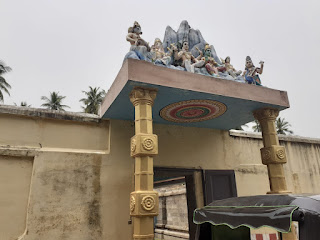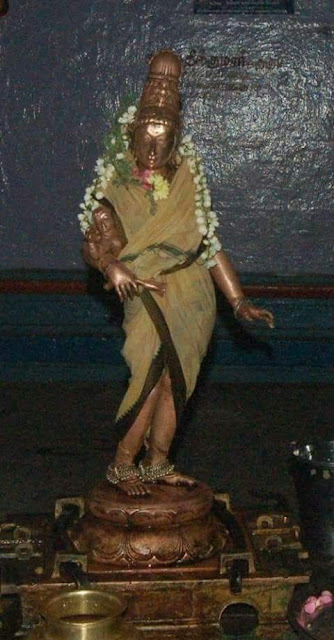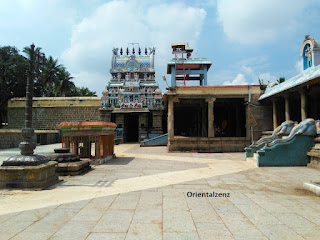There are
three Shiva Temples with Arjuna Tree as a “Sthala-vruksham”. They are
- Srisailam – Mallikarjuna Jyothirlinga
Temple, Andhrapradesh
- Thiruvidaimaruthur – Mahalinga Swamy
Temple, Tamil nadu
- Thirupudaimaruthur – Putarjuneshwar
Temple, Ambasamudhram Taluk, Tirunelveli district, Tamil nadu.
Arjuna
Tree:
It is called
Marudha Maram in Tamil, Arjun in Hindi. In Sanskrit, Arjuna means either bright
or white. The flowers of Arjuna tree are white in color
The
significance of the Arjuna Tree are mentioned in various Ayurveda texts. Astanga
Hridaya of Vagbhata explicitly speaks about the Arjuna tree. The below slokas
are in Chapter 15 of Astanga Hridaya and This chapter deals with various herbs
which are used in Panchakarma (Ayurveda treatmeents).
न्यग्रोधपिप्पलसदाफलरोध्रयुग्मं
जम्बूद्वयार्जुनकपीतनसोमवल्काः प्लाक्षाम्रवञ्जुलप्रियालपलाशनन्दीकोलीकदम्बविरलामधुकं
मधूकम्
Nyagrodha,
Pippala, Sadaphala, the two Rohra, the two Jambu, Arjuna, Kapitana, Somavalka,
Plaksa,
Amra, Vanjula, Piyata, Patasa, Nanon, kon, Kadamba, Virala, Madhuka and
Madhuka-
नयग्रोधादिर्गणो
व्रण्यः सङ्ग्राही भग्नसाधनः मेदः
पित्तास्रतृड्दाहयोनिरोगनिर्बहणः
this
nyarodhadi group is good for wounds/ ulcers, cause constipation, unites
fractures, cures fat accumulation, bleeding disease, thirst, burning sensation,
and diseases of Vagina. 41-42
The flowers,
barks, leafs and fruits of Arjuna tree have the capability to cure the heart
ailments, even it is being touted as a “Guardian of Heart”. Various Ayurveda
texts including Charaka Samhita, Sushruta Samhita speaks about qualities as
well as medicinal properties of Arjuna tree.
In this
context, this Arjuna tree (Maruda vruksham) is being associated with three
shiva temples as mentioned above. Out of this three temples, SriSailam temple
in Andhra Pradesh is being the most famous one since it is one among 12
jyothirlinga kshetras and Thiruvidaimaruthur temples is also famous among
Aasthikas but not to the extent of Srisailam. However, another Shiva Temple “Thirupudaimaruthur
or Putarjuna kshetram in Sanskrit” is not that quite popular.
Thirupudaimaruthur
– Kshetra Mahatmyam:
Brahma,
Narayana, Mahalakshmi, Saraswati and all devas requested Mahadeva to show them
the great place to worship him in Bharatavarsha. Mahadeva asked Brahma to throw
his brahma dhanda into Ganga and Asked all devas to follow the Brahma dhanda and
where it stops, the respective place would be the one which all devas aspired.
Similarly,
the brahma dhanda reached the merging point of “Tamraparni river and Sea” and
then it traveled against the flow of Tamraparni river towards western side and
stopped at the sangham point of “Tamraparni river with its tributary Kadana
river”. In this place, all devas along with Brahma and Narayana established the
Shiva linga and worshipped it along with brahma dhanda. The same Brahma dhanda
can be even seen now in front of goddess ‘Gomathi ambal” sanctum.
This
particular shiva linga later submerged into the sand. After long time, the
local pandya king came to the banks of Tamraparni river while chasing a deer.
The respective deer went downwards of the “arjuna tree” and While chasing it, the
king located the Shiva linga and re-established it with full grandeur in a newly
constructed temple. The downside part of arjuna tree where the deer disappeared
can be even seen today on the back side of the temple near the shrine of Ganesha.
From
Tamraparni Mahatmyam:
Following
are excerpts from the Tamraparni Mahatmyam,
When the
Sage among Sages Agasthya the one who brought the Tamraparni river along with
him during his Dhakshina Bharata yatra, came to this kshetra along with his
wife Lopamudra, When he entered this kshetra, he reached the eternal happiness
and following are his expression while had a dharshan of this Maha kshetram
Thirupudaimaruthur
“Agasthya
Maharishi saw the The shiva linga which was there inside “Arjuna tree (Marudha
tree)” – The one which possess the Brahmananda, Tapopala (the desired results
through penance) of Agasthya, the nectar drop emerged from the ocean”.
Aadhi
Manu and Thirupudaimaruthur:
As per the
guidance of Agasthya, Aadhi manu the one who is the first “manushya” as per our
Puranas intent to worship all the “Swayambu linga ksthetras on earth” and reached
Thirupudaimaruthur. While reaching, he had seen that Mahalakshmi, Saraswati and
all devas near the Arjuna tree on the banks of Tamraparni river and while he
came near, they all had disappeared in the tree and he took his knife and tried
to cut the tree. But due to divine intervention, he realised the presence of
Mahadeva and built the temple and later the temple built by Manu turned ruins.
Devendra and
Brahma hathi dosha”
Another important
aspect associated with all these three shiva temples which are associated with “Arjuna
tree” is its ability to wash away the “Brahma hathi dosha”.
In
Thirupudaimaruthur, Devendra got relieved from Brahma hathi dosha after taking
punya Snanam in Tamraparni & Kadana river sagham point and after worshipping
“Putarjuneshwar”. Devendra got this Brahma hathi dosha since he killed his guru
“Vrudhrasura” who was deva guru for brief period of time and this particular remedy told by Brahspathi to Indra.
Indra came
to this Thirupudaimaruthur and took punya Snanam in “Tamil month – Thai &
Pusya Nakshatram and Guru horai” and got relieved from his Brahma hathi dosha.
This
particular incident is still even today being celebrated as a festivel in “Tamil
month – Thai Pusya star day” as a “Tirthavari utsav. In this particular day,
Utsav murthy of Putarjuneshwar comes to “Tamraparni river” bank in “Rishibha
vahanam” and give dharshan to Indra’
Karuvur
Chithar & Thirupudaimaruthur:
An ardent
devotee of Shiva – Karuvur Chithar the one who was associated with the greatest
king of Bharata varsha from Tamilnadu “Raja Raja Chola” came to the northern
bank of Tamraparni river but he was unable to cross the river due to heavy
floods. Due to his plead to mahadeva, Putarjuneshwar asked him to cross the
river with the focused meditation on him. Similarly, Karuvur chithar crossed
the river and had a dharshan of Putarjuneshwar.
Since
Putarjuneshwar heard the pleading of Karuvur chithar, the shiva linga bit tilted
on its left side and we can have a dharshan with the same tilted posture even
today.
Significance
of the Temple:
- Here, Tamraparni river flows northern
wards “as a Uttara vahini” and turns eastern “as a Poorva vahini” exactly at
this place. Whereever, the river flows northwards, the respective places are
considered equivalent to Kashi since Ganga turns northwards when it enters the
ever holy maha kshetra kashi.

- In Thirupudaimaruthur, another tributary
of Tamraparni “Kadana river” merges with Tamraparni along with antarvahini Saraswati”. Due to the sangham of three rivers, “the place located on
northern bank of Tamraparni” is being called as “Mukkudal (tamil name for
Triveni sangham”
- Thirupudaimaruthur temple is one
among the three temples which has “Arjuna tree / Marudha maram in Tamil as a
sthala vruksham.
- Thirupudaimaruthur temple and
Tamraparni river are one among the most sacred places in Bharatavarsha which
have the potential to wash away the most harmful “Brahma hathya dosha”.
- The person who has the mental illness
comes to the temple and worshipped for 21 days will get cured.
- According the “Tamraparni Mahatmyam”,
there are 11 tirthas situated in Tamraparni river around this
Thirupudaimaruthur temple.
- Narayana, Mahalakshmi, Brahma,
Saraswati and All devas have worshipped here.
- The greatest sage among all sages “Agasthya”
came and worshipped here and had his punya snanam along with his wife Lopamudra
Significance
of Various Tirthas of Thirupudaimaruthur:
All this
below mentioned tirthas are situated in Tamraparni river only but in various
locations in and around Thirupudaimaruthur and they are not separate kunds or
wells but all are in Tamraparni river only, All of these tirthas and
Significance are mentioned in Tamraparni Mahatmyam
- On the southern side of
Putarjuneshwar Temple, there is tirtha called Putarjuesha tirtha or Devendra
moksha tirtha which was earlier washed away the sins of Devendra,
- On further south, there is tirtha called
“Gowthama Tirtha” and Agasthya rishi did Snanam in this tirtham along with his
wife lopamudra and did the Tarpanas to Rishis and devas.
- Bit further south, there is a tirtha called
“Paisasamochana tirtha” and who does the Snanam here won’t see the place of
yema and they will directly liberate from the birth and death cycle.
- Bit further south, there is tirtha
called “Dhanadapavanam” which does wash away all sins i.e mahapapas.
- Further down south, there is Sangham
place where Tamaraparni river merges with Kadana river and Antarvahini
Saraswati and the one who does the Snanam here will attain all his dharmic
desires.
- Bit further south, there is tirtha
called “Maandavya tirtha” and the one
who does the Snanam here will reach Brahmaloka
- On northern side, there is tirtham called
“Vinayaka tirtha” and the one who does the Snanam here will get longevity of
life.
- On further north side, there is tirtha
called “Karma tirtha” and the one who touches this tirtha will get relieved
from all his/her karma cycles.
- There is one more Tirtha called “Rakshashi
vimochana tirtha” and the one who just sees this tirtha, will get relived from
all sins.
Temple
Architecture:
- At
Garbhagriha, Putarjuneshwar is there with tilted posture
- Yoga
Dakshina moorthy is an another main attraction in this temple.
- Gomathi
ambal Garbhagriha is located in the southern side of Putarjuneshwar.
- Apart
from this, there are shrines for Subramanya, Nataraja, Sahasra lingam, Bhairav
etc.
- At
the entrance, there is sculpture of Pandya king who built this amazing temple.
Main
Festivals
There is
annual 10 days festival celebrated in Tamil month “Thai” ( in January /
February) and the tenth day usually falls on Pushya nakshatra day. There will
be “Tirthavari (the deity will come to Tamraparni river)” on this tenth day.
This is the most significant annual festival and it related to temple’s kshetra
mahatmiyam. There will be floating festival happening on this tenth day night
and it is being called “Tepothsavam” in Tamil.
Apart from
this, Maha shivratri, Aarudhra dharshan in December / January month, Poornima
day in Krithika month are also being celebrated grandly.
Recently,
Tamraparni Pushkaram was celebrated with full grandeur by all aasthikas.
Location:
Thirupudaimaruthur
is a small village on the banks of Tamraparni river. It is in Ambasamudhram Taluk and Tirunelveli district and fully surrounded by Paddy fields and enriched forever by Tamraparni river.
It is
located 28KM from Tirunelveli on western side. There are regular buses from
Tirunelveli to Papanasam and the devlotees have to get down at the town called
Veeravanallur and there are autos/ taxis available to Thirupudaimaruthur which is
around 8KM from Veeravanallur. Devotees can also book private vehicle from
Tirunelveli and which is the most convenient way.
Other
Places to look around
- This temple is situated along with
other “Nava kailsha” temple.
- Hence, when the devotees do the yatra
to “Nava kailasha” temples, they can go to Thirupudaimaruthur also.
- Gajendra moksha kshetram is very near
to this temple.
- Also, Brahmadesam which has one of
the oldest shiva temple and the place where second guru of Kanchi kamakoti
peetam got birth is also very near to this temple i.e around 8KM.
Temple Timing:
Temple is open for dharshan from morning 6:00 AM to 11:00 AM and evening 4:00 AM to 8:00 AM
Source: Tamraparni Mahatmyam Book,
https://www.ayurvedatreatments.co.in/ayurvedatreatments/index.php/e-book-downloads



















